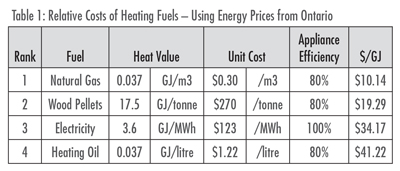
Pellet Awakening
March 26, 2013
By Gordon Murray
I have to confess that I have been working under a huge misconception about the potential for wood pellets in the Canadian residential, commercial and institutional heat markets.
I have to confess that I have been working under a huge misconception about the potential for wood pellets in the Canadian residential, commercial and institutional heat markets. I have just assumed that since natural gas was cheap and convenient, wood pellets could only occupy a niche market in the few areas of Canada not covered by our country’s natural gas network. I could not have been more wrong.
I spent some time analyzing data from Statistics Canada and the Hearth, Patio and Barbeque Association of Canada (HPBA) and have found some very interesting facts:
- Only 47% of Canadian homes, businesses, and institutions use natural gas for heat and hot water. The other 53% use heating oil, electricity, propane, and wood, consuming 1,033 petajoules of energy annually. Assuming an average pellet appliance efficiency of 80%, this is the equivalent of 75 million tonnes of wood pellets every year.
- Energy used by the residential sector is about the same as that used in the commercial/institutional sector.
- Just 6% of Canadian homes use wood as their primary heat source, and of those, the split is 95% firewood and 5% wood pellets. That means that wood pellets are used as the primary source of heat in just 0.3% of Canadian homes. Each of those homes uses an average of 3.9 tonnes of pellets annually for a total of just 175,500 tonnes annually. A single plant can easily produce that many pellets.
- Although wood pellets are more expensive than natural gas, they are substantially cheaper than heating oil or electricity, which are presently the two most popular non-gas sources of energy for heat and hot water (Table 1). Pellets become even cheaper as volumes grow due to improved economies of scale and switching to bulk from bagged product.

|
|
In addition to their attractiveness as a low-cost fuel, there are other advantages to using wood pellets to provide energy for heat and hot water:
- Wood pellets are a renewable carbon-neutral fuel. Using wood pellets would help the Government of Canada meet its goal of reducing GHG emissions by 17% by 2020 from 2005 levels.
- It would provide jobs in rural areas and keep money circulating close to where the pellets are used.
- Modern wood pellet appliances are every bit as convenient as gas furnaces. Pellets are stored in bulk and auto-fed into the appliance as needed. Temperature is set thermostatically, just the same with a gas or oil furnace. Generally appliances only need to be maintained about twice a year and pellet ash is removed automatically.
- We would be able to use pellets here at home rather than having to rely almost solely on exports to the European power sector. Using pellets for heat is far more efficient than using pellets to create electricity (typically 80% versus 35% efficiency).
- As the domestic market grows, bulk deliveries would replace bags. A combination of increased volume together with reduced handling and packaging would lower pellet costs substantially.
- It would free up oil and electricity for other higher-value purposes.
Further research shows that Canada’s potential wood pellet heating market, assuming that all non-natural gas heat and hot water in the residential and commercial/institutional sectors is converted to wood pellets, is 75,957,000 tonnes. While it is unrealistic to assume a 100% share of the non-gas market for wood pellets, a 3% share is likely achievable. And 3% of the non-gas heat market amounts to 2,279,000 tonnes of wood pellets each year – a total value of nearly $570 million.
If you consider that Austria, Germany and Italy together are just a fraction of the size of Canada and that their combined pellet heat markets total about four million tonnes, it is not hard to imagine that we could achieve a heat market of 2.3 million tonnes of wood pellets here in Canada.
In my next column, I will discuss the steps needed to reach this target.
Gordon Murray is executive director of the Wood Pellet Association of Canada. He encourages all those who want to support and benefit from the growth of the Canadian wood pellet industry to join. Gordon welcomes all comments and can be contacted by telephone at 250-837-8821 or by e-mail at gord@pellet.org.
Print this page